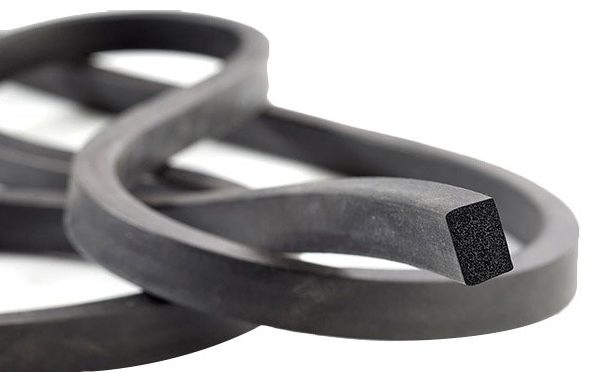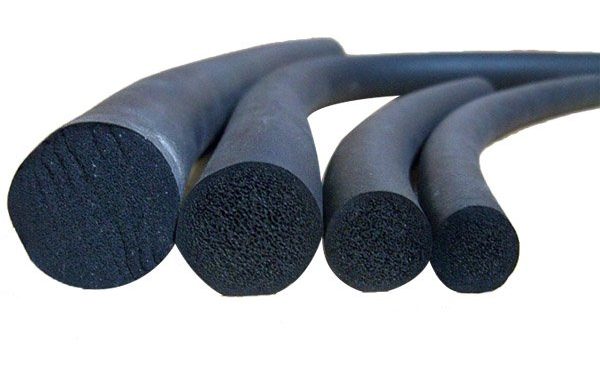Foam and sponge rubber are both versatile materials originating from typical rubber compounds. They play a crucial role in sealing, insulation, and cushioning properties. In addition, they provide excellent flexibility, compressibility, and liquid absorption properties. As a result, they can provide an option for cushioning and conforming to irregular surfaces. Therefore, understanding foam vs. sponge rubber is crucial. It also helps to choose the suitable rubber materials for your project.
This article aims to provide a comprehensive understanding of foam vs. sponge rubber. It explores foam vs. sponge rubber seals’ types, differences, and applications. We hope this article will help make informed decisions when selecting the suitable materials between foam and sponge.
What Is Foam Rubber?
Foam rubber is a rubber substitute that is different from regular rubber. It differs from traditional solid rubber due to its unique cellular structure. The typical cellular shape of foam rubber is closed-cell. This cellular arrangement can be achieved through foaming. The process inserts gas or air into the rubber compound during manufacturing. Then, it forms a network of interconnected air pockets within the materials. It results in a lightweight and porous texture. As a result, they become the best choice for sealing, especially for preventing wind, water, and dust.
Another critical feature of foam rubber is its remarkable insulation properties. Foam rubber prevents heat and cold from the trapped air with its cells. In addition, foam’s cellular structure provides effective sealing properties. When compressed, the cells create a barrier that restricts the passage of air, water, and other substances. As a result, foam rubber is an excellent choice for weatherproofing doors, windows, and other gaps.
What Sponge Rubber?
Sponge rubber is also a particular rubber variant characterized by its unique cellular structure. This unique characteristic sets it apart from traditional solid or foam rubber. The cellular shape of sponge rubber is open-cell. This particular arrangement comes with sealed air pockets. It results in interconnected voids within the material.
The flexibility of open-cell sponge rubber allows it to bend, conform, and adapt to irregular surfaces. As a result, it becomes an ideal choice for applications where traditional rubber may fall apart. In addition, sponge rubber exhibits exceptional compression properties. It can readily deform under pressure to provide cushioning and absorb shocks. The open-cell structure also enables sponge rubber to absorb and retain liquids. As a result, sponge rubber is ideal for moisture absorption applications.
Types Of Foam And Sponge Rubber
When we delve deeper into the realm of foam vs sponge rubber, we encounter various types that cater to diverse applications. Interestingly, each type possesses distinct attributes but shares a common material foundation. Therefore, based on these, we have classified foam and sponge rubber into eight primary types. You may find additional types, but the following are the most common.
EPDM Foam Seal And EPDM Sponge Rubber Seal
EPDM stands for Ethylene Propylene Diene Monomer. This rubber material provides impressive weather resistance, UV stability, and ozone resilience. EPDM is also famous for its flexibility and longevity. As a result, they are ideal for applications that are exposed to the elements over extended periods. The EPDM foam seal and EPDM sponge rubber seal are also trusted choices for various temperature control applications.
EPDM foam seal is famous in weatherstripping applications. These seals act as a barrier against air, moisture, and dust infiltration. On the other hand, the EPDM sponge rubber seal is found in cushioning, absorbing shocks, and vibrations applications.
NBR Foam And NBR Sponge
NBR stands for Nitrile Butadiene Rubber, which also emerges as a versatile contender in foam and sponge rubber variations. This rubber material is excellent for oil resistance. Besides, it also offers impressive durability and resistance to abrasion. In addition, it also provides resilience against fuels and various chemicals. You may find a lot of NBR foam and sponge rubber seals.
NBR foam is prevalent in applications where protection against oil permeation is crucial. NBR foam gaskets and seals are highly valuable in automotive and industrial settings. On the other hand, the NBR sponge is used in demanding shock absorption and padding application. Various industries use it as a protective layer in equipment, machinery, and automotive interiors.
Neoprene Foam Rubber And Neoprene Sponge Strip
Neoprene is a synthetic rubber famous for its remarkable durability and robustness. This material’s inherent strength makes it an ideal choice for demanding applications. It provides excellent longevity and resistance to wear and tear. In addition, neoprene boasts commendable weather resistance. As a result, it became a reliable product for outdoor and exposed environments.
Like EPDM, Neoprene foam rubber is also prevalent in weatherstripping applications. On the other hand, a neoprene sponge strip comes with excellent vibration-dampening properties. As a result, it is an ideal choice in various industries where machinery and equipment generate vibrations.
Silicone Foam Rubber And Silicone Sponge Rubber
Silicone rubber offers unparalleled high-temperature resistance and exceptional flexibility. This combination makes silicone rubber ideal for applications in extreme conditions. However, there are multiple forms of silicone rubber strips. Among them, silicone foam rubber and silicone sponge rubber are noteworthy.
Silicone foam rubber finds applications in extreme temperature uses. From industrial settings to aerospace applications, silicone foam rubber stands its ground. It ensures reliable sealing and insulation. On the other hand, silicone sponge rubber finds applications requiring adaptability. In addition, it also provides the ability to conform to irregular shapes. It fulfills the Industries’ requirements, seeking effective sealing, cushioning, and compression resilience.
Neoprene/EPDM Rubber
The convergence of neoprene and EPDM creates specialized rubber blends. Together, they form a powerful combination that caters to industries requiring both attributes. Neoprene’s durability meets EPDM’s oil resistance in a potent mix. This fusion excels against harsh weather and shields against oils and chemicals. Industries benefit across automotive, marine, and manufacturing sectors.
The fusion of neoprene and EPDM in rubber blends is an innovation in material science. The strength of these materials enhances industries’ operational efficiency and longevity. They can also epitomize the concept of adaptable materials meeting multifaceted demands.
Nitrile/PVC Rubber
The combination of nitrile and PVC creates a rubber mix that harmonizes oil resistance and affordability. Nitrile’s oil resistance and PVC’s cost-effectiveness unite, delivering practicality without compromising performance.
In the automotive and machinery sectors, Nitrile/PVC blends find their application. They offer robust protection against fluids and cost-effective options for oil-resistant parts. This amalgamation showcases material engineering mastery, marrying nitrile’s strength with PVC’s advantages. It underscores how innovative blending addresses functionality and budget.
Polyester Foam Strip
Polyester foam strips offer remarkable compression set resistance. They retain shape post-compression for unwavering performance. However, these rubber strips are vital for applications where consistency is a prime concern.
From sealing against elements to cushioning in machinery, these strips offer reliability. They showcase the adaptability of foam and sponge rubber. In addition, they ensure steadfastness amid diverse demands. This makes them an indispensable asset in reliability-driven industries.
Wetsuit Neoprene Sponge Strip
Wetsuit neoprene sponge strips are tailored for marine and water sports applications. It harnesses neoprene’s buoyancy and insulation. They shield against moisture in marine equipment while cushioning impacts. In water sports gear, they offer comfort and buoyancy.
These strips exemplify material specialization, adapting to water-based environments seamlessly. They highlight foam and sponge rubber’s versatility by meeting unique needs. Moreover, they enhance experiences and safety in specific industries.
Foam Vs Sponge Rubber: What’s The Difference?
Understanding foam vs sponge rubber is necessary to find the ideal product for your project. The differences differ in their physical and molecular properties. In the following, we have summarized the differences in a table. We hope you can easily understand this table and make informed decisions.
| Aspect | Foam Rubber | Sponge Rubber |
| Cellular Structure | Open or closed cells | Mostly open Cells |
| Compression | Less compressible | More compressible |
| Density | Generally higher | Generally lower |
| Sealing Properties | Effective for sealing | Less effective for sealing |
| Cushioning | Limited cushioning | Excellent cushioning |
| Water absorption | Lower absorption | Higher absorption |
| Application | Sealing, insulation, packaging | Cushioning, packaging, shock absorption |
| Weight | Heavier | Lighter |
| Flexibility | Less flexible than sponge rubber | More flexible than foam rubber |
Foam vs Sponge Rubber Difference Table
Remember that these characteristics can vary based on specific formulations and manufacturing processes. The choice between foam and sponge rubber depends on the application’s requirements. You can consult the manufacturer’s customer service team to learn more about their products.
Summary
Throughout the article, we learned some basics of foam and sponge rubber. It covered material composition, cellular structure, types, and applications. Foam rubber’s closed or open cells offer effective sealing and insulation. On the other hand, sponge rubber’s open-cell structure excels in cushioning and shock absorption.
Different types of foam and sponge rubber provide a wide range of benefits. As a result, they find applications in various industries. In this case, we have categorized foam and sponge rubber into eight primary categories. However, the combination of neoprene and EPDM balances weather resistance and oil repellence at the same time. Consequently, the blend of nitrile and PVC embodies practicality without compromising performance.
The significance of choosing a suitable material cannot be overstated. Each type offers unique benefits. In addition, selecting the appropriate one is crucial for optimal performance and longevity. By understanding the fundamentals of each material, readers can make informed decisions.
Remember that the right choice can enhance efficiency, safety, and durability when selecting a material. Whether any use, the knowledge gained empowers you to navigate the intricate landscape of foam and sponge rubber. It also ensures your choices align perfectly with your specific requirements.


